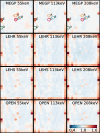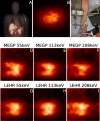Characterisation of a hand-held CZT-based gamma camera for 177Lu imaging
- PMID: 32642884
- PMCID: PMC7343677
- DOI: 10.1186/s40658-020-00313-y
Characterisation of a hand-held CZT-based gamma camera for 177Lu imaging
Abstract
Background: Currently, hand-held gamma cameras are being developed for 99mTc imaging, mainly for sentinel lymph node detection. These cameras offer advantages, such as mobility and ease of access, and may be useful also for other applications such as biokinetic studies in animals or for imaging of small, superficial structures in patients. In this work, the suitability of a CZT-based hand-held camera for 177Lu imaging is investigated. The energy response of CZT-based detectors combined with the multiple photon emissions of 177Lu poses new challenges compared to 99mTc imaging, and a thorough camera characterisation is thus warranted.
Methods: Three collimators (LEHR, LEHS, and MEGP) and three energy windows (55 keV, 113 keV, and 208 keV) are investigated. Characterised camera properties include the system spatial resolution, energy resolution, sensitivity, image uniformity, septal penetration, and temperature dependence. Characterisations are made starting from NEMA guidelines when applicable, with adjustments made when required. The applicability of the camera is demonstrated by imaging of a superficially located tumour in a patient undergoing [177 Lu]Lu-DOTA-TATE therapy.
Results: Overall, the results are encouraging. Compared to a conventional gamma camera, the hand-held camera generally has a higher sensitivity for a given collimator. For source-collimator distances below 3 cm, the spatial resolution FWHM is within 6 mm for the LEHR and MEGP collimators. Before uniformity correction, the central field-of-view integral uniformity shows best results for the 113-keV window, with values obtained between 11 and 14%. The corresponding values after uniformity correction are within 3%. Effects of septal penetration are observed but are manageable with a proper combination of collimator and energy window setting. Septal penetration and collimator scatter not only affect the 208-keV window but also contribute with counts in lower windows due to energy-tailing effects. The patient study revealed non-uniform uptake patterns in a region that appeared uniform in a conventional gamma camera image.
Conclusions: The results show that the hand-held camera can be used for 177Lu imaging. A 113-keV energy window combined with LEHR or MEGP collimators provides the best image system characteristics.
Keywords: 177Lu; CZT; Hand-held gamma camera; Molecular imaging.
Conflict of interest statement
AS has been a consultant, lecturer, and advisory board member for Novartis, Ipsen, and Spago Nanomedical. KSG has been a consultant for Fusion Pharmaceuticals Inc. DR and EL declare that they have nothing to disclose.
Figures










References
-
- Kerrou K, Pitre S, Coutant C, Rouzier R, Ancel P-Y, Lebeaux C, Huchet V, Montravers F, Pascal O, Duval M-A, Lefebvre F, Menard L, Uzan S, Charon Y, Barranger E. The usefulness of a preoperative compact imager, a hand-held γ-camera for breast cancer sentinel node biopsy: final results of a prospective double-blind, clinical study. J Nucl Med. 2011;52(9):1346–53. doi: 10.2967/jnumed.111.090464. - DOI - PubMed
-
- Popovic K, McKisson JE, Kross B, Lee S, McKisson J, Weisenberger AG, Proffitt J, Stolin A, Majewski S, Williams MB. Development and characterization of a round hand-held silicon photomultiplier based gamma camera for intraoperative imaging. IEEE Trans Nucl Sci. 2014;61(3):1084–91. doi: 10.1109/TNS.2014.2308284. - DOI - PMC - PubMed
LinkOut - more resources
Full Text Sources
Miscellaneous

